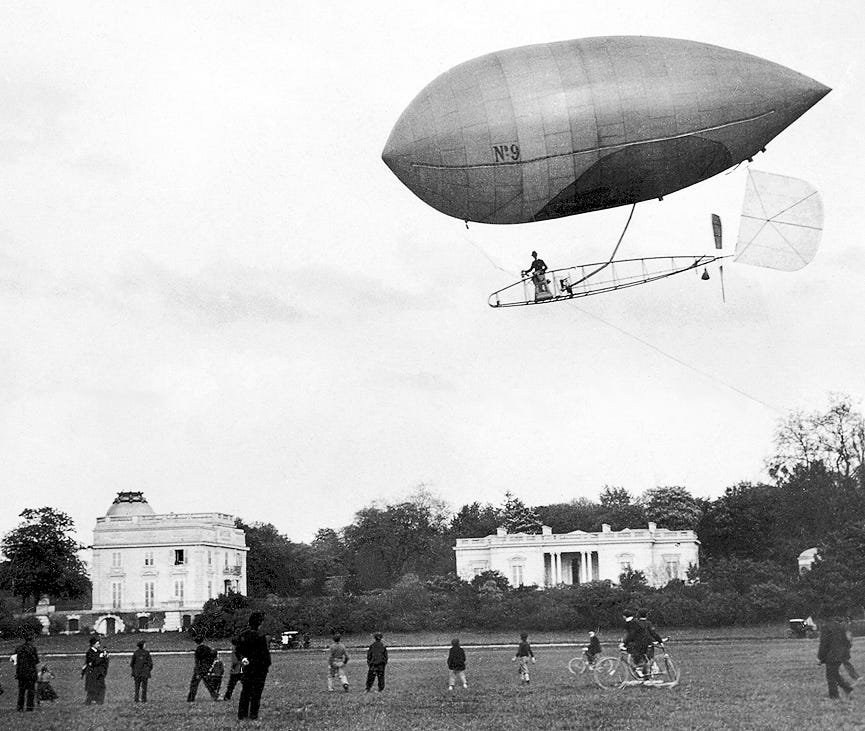Welcome to Thursday Things! If you enjoy this edition, please click the heart icon in the heading or at the end of the post to let me know. You can also post a comment by clicking the dialogue bubble next to the heart.
Alberto Santos-Dumont flies the 14-bis, 1906.
Study reveals what the brain does during daydreams What happens when your mind begins to wander from the task at hand and you slip into daydreams? Good things, actually. It is important to be able to focus, but to enable that sometimes you also need to let your mind drift. That’s how people come up with ideas like, say, inventing a flying machine. It’s not me saying this — it’s Science!
Researchers have found a way to track what your mind is doing when thoughts begin to wander.
Using electroencephalograms, or EEG, to measure brain activity while more than two dozen study participants did mundane attention tasks, the researchers identified brain signals associated with a daydreaming mind.
They found that the participants had increased alpha brain waves in the prefrontal cortex when their thoughts skipped from one topic to another.
Alpha waves are slow brain rhythms with frequency ranging from 9 to 14 cycles per second.
The findings provide an electrophysiological signature for free, spontaneous thought, according to the researchers.
They also found that the participants had weaker brain signals known as P3 in the parietal cortex when they weren't paying attention to the task at hand.
Here at Thursday Things, we’re all alpha waves all the time.
The Moon disappearing is never a good sign. In 1110, The Moon Vanished From The Sky. We May Finally Know Why
Almost a millennium ago, a major upheaval occurred in Earth's atmosphere: a giant cloud of sulphur-rich particles flowed throughout the stratosphere, turning skies dark for months or even years, before ultimately falling down to Earth.
We know this event happened because researchers have drilled and analysed ice cores - samples taken from deep within ice sheets or glaciers, which have trapped sulphur aerosols produced by volcanic eruptions reaching the stratosphere and settling back on the surface.
… In this case, scientists had assumed the sulphurous deposit was left by a major eruption unleashed in 1104 by Iceland's Hekla, a volcano sometimes called the 'Gateway to Hell'. Since the thin strip of ice ranks among the largest sulfate deposition signals of the last millennium, it sounds plausible.
Only, what if the accepted timeline of an ice core turns out to be time-warped?
It turns out scientists may have been blaming the wrong volcano all this time. Who was the real culprit? Read the whole thing to find out!
And get all the science details at Climatic and societal impacts of a “forgotten” cluster of volcanic eruptions in 1108-1110 CE
When I’m not Thursday Thinging, I’m writing novels. One challenge if you’re writing books set in contemporary times is incorporating the reality of our online - mobile - texting - ADD - fragmented media environment world. Most of my books are not set in the real world, so it has been less of an issue for me. This article nevertheless fascinated me: Page refresh: how the internet is transforming the novel
Characters in today’s novels are more likely to surprise us if they don’t use social media. This is often put down to their age, or pious superiority, or eccentricity, or something very sinister in their past. In Raven Leilani’s debut Luster, the narrator’s older love interest (met via online dating) uses “retired internet slang”, and is “not even on Twitter”. Unlike with men her own age, she cannot track his “formative development online”, and this adds to his allure.
Similarly, in Lauren Oyler’s forthcoming Fake Accounts, the narrator’s boyfriend appears to have minimal internet presence (suspicious), then turns out to have a secret online avatar with a considerable Instagram following. A famous author in Rebecca Watson’s little scratchwho is not on social media is described as seeming like “a dead writer”. Meanwhile, in Patricia Lockwood’s debut novel No One Is Talking About This (published next month) the protagonist knows only two living people without a digital trail – a former school friend, who seems to have escaped into a parallel universe offline, and her own newborn niece.
If you’re a writer— or a reader of contemporary fiction (I tend to prefer the Jules Verne / Sherlock Holmes era when all authors had to worry about was the impact of the telegraph and the new-fangled wireless on fiction) — read the whole thing for interesting observations about the interplay of the internet and novels in 2021.
A memória de Santos Dumont pede socorro: Acumulando dívidas e sem dinheiro para reforma, Casa de Cabangu, tributo ao maior inventor brasileiro na Serra da Mantiqueira, tenta evitar o destino do Museu Nacional (Santos Dumont's memory calls for help: Accumulating debts and penniless for renovation, Casa de Cabangu, a tribute to the greatest Brazilian inventor in Serra da Mantiqueira, tries to avoid the fate of the National Museum)
I’ll quote this in English for those who don’t read Portuguese, courtesy of Google Translate: “Casa de Cabangu, the house where Alberto Santos Dumont was born and later lived as a farmer, is today maintained as a museum celebrating the famous aviation pioneer. Except "maintained" is a bit strong: "With no cash Casa Natal de Santos Dumont has already closed its doors twice in less than 12 months. ... In October, the museum promoted crowdfunding to pay for employees' back wages and more urgent repairs to the structure of the house ... only 7000 reais (Brazil bucks) were raised, less than 3% of the target."
The house, outside the city of Minas Gerais, is in bad shape due to a lack of money for maintenance. The roof is corroded, leaks in the library have damaged Dumont’s rare early aviation books, there are are some kind of wood-burrowing bees eating the pavilions. Many of Santos-Dumont's letters, cannot be displayed because the museum has no money to restore and frame them. It’s sad.
Unless you’re Brazilian or interested in aviation history, you might wonder who the heck was Alberto Santos-Dumont? Dumont was an inventor and early aviator who had a remarkable career. He is considered a national hero in Brazil, where they also believe he preceded the Wright brothers in demonstrating heavier-than-air flight. Which, as an American, I have to say is absurd. But that’s what they believe. And it is fun to have those arguments, and learn something in the process.
Sad, then, that their national hero’s place of birth is in such sad shape. Brazil seems in general to be a country that doesn’t much care about preserving its past. But the reason for this item is not to pick on Brazil, nor bemoan the sad state of this particular site. Here in the U.S. it seems the neglect of history and national heroes would be an improvement over the recent trend by some to actively attack the past. How many statues of national heroes and other men and women of accomplishment have we seen defaced and destroyed in the last year? Thursday Things is not about politics. But we hold and will not yield on the point that history is worth preserving and remembering and passing on. We can learn from both the mistakes and all to human flaws of our heroes as well as be inspired by their achievements and admirable qualities. Erasing the past — or letting freaky Brazilian bees eat it — is a tragedy we should not allow.
“Could you kindly direct me to dirigible parking? Oh, wait, I’m the only guy in Paris who has one.”
Thank you for reading Thursday Things. Again, please click the hearts, comment, and use the share button to send this issue to a friend who might enjoy it. See you next Thursday!




